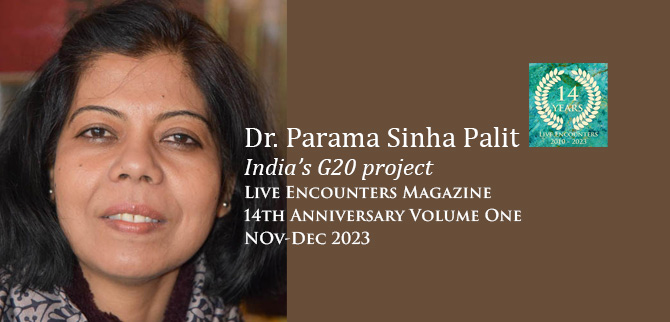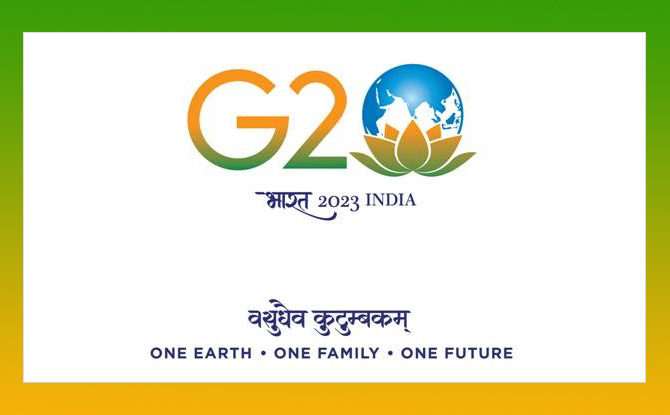
Download PDF Here
14th Anniversary Edition, Live Encounters Magazine, Volume One Nov-Dec 2023.
India’s G20 project: Brand-building for political messaging
by Dr. Parama Sinha Palit.

India’s G20 Presidency has been an exhaustive effort in projecting the idea of ‘Brand India’ centrally positioned on the image of its Prime Minister Narendra Modi.
The ‘Brand India’ identity has been in the works for quite some time. In 2021, Modi emphasized India’s role as a ‘reliable, democratic partner’ at the United Nation General Assembly. During the same year, he conveyed India’s desire to assume global responsibility at the Quad first in-person Leaders’ Summit. The ‘Brand India’ message was substantially expanded at the World Economic Forum, Davos, in 2022. Modi not only highlighted the country’s capabilities in innovation, technology adaptation and entrepreneurship, but also its ability to be a reliable partner in global supply chains. India’s global social responsibilities by committing to safeguarding environment through climate-friendly lifestyles was advanced through ‘Lifestyle for Environment’ (LiFE) on the same occasion. LiFE figured prominently on the Indian agenda during its Presidency of G20, as did its accomplishments on digital public infrastructure, outlining its digital diplomacy strategy focusing on a human-centric approach to technology.
Establishing ‘Brand India’ has been a key objective of Modi’s BJP in the foreign policy arena. The BJP’s manifesto for the general election of 2019, which elected Modi to office for a second term, underscored the Party’s vision to ‘fundamentally reboot and reorient’ India’s foreign policy goals ‘in a manner that locates India’s global strategic engagement in a new paradigm and on a wider canvass’. Establishing ‘Brand India’ for enhancing the country’s reputation both globally and locally was an important part of the vision. The effort represents strategies of modern nation states and their governments to generate specific agendas for communicating with the new glocal public.
Contemporary political communication emphasizes agenda setting for engaging public attentions on the same, thereby enabling governments to achieve certain purposes, including exercising greater influence through foreign policies. The BJP has explicitly pursued agenda setting for making foreign policy deliver both global and local goals. With the next general election a few months away, ‘Brand India’ has been used purposefully for stretching India’s global influence and using the same for conveying political messages to the domestic constituencies. Prime Minister Modi – the BJP’s face and its biggest electoral asset, as well as a global leader with strong strategic heft – has been seamlessly blended into the visualization of ‘Brand India’.
Advancing ‘Brand India’ has faced significant challenges. The context of India’s G20 Presidency was marred by hostile great power rivalry, India’s own strained ties with China and the indefinitely prolonging Russia-Ukraine conflict. Irreconcilable differences between the G7 and other G20 members on the Ukraine conflict on the one hand, and other key agenda issues (e.g., reforming global financial institutions, affordable climate finance) on the other, posed as key hurdles. Challenges continue to persist even after the successful delivery of the Leader’s Declaration with the India-Canada row threatening to impact ‘Brand India’. There were also significant domestic challenges: ethnic strife in India’s north-eastern state of Manipur and communal violence in the Northern Indian state of Haryana figured prominently in the greater global and national media coverage on India in the run-up to the G20 Summit.
By managing a consensus among the G20 members on the Ukraine issue, securing membership for the African Union (AU) and pushing China to the margins of the Summit, India consolidated its brand image as a responsible global actor communicating the Voice of the Global South – a role where it competes with China. By doing what it did, ‘Brand India’ has made itself widely visible in the global strategic discourse. The visibility was obtained by India’s efforts to chart out a decisive course in external engagement, unaffected by disruptions caused by estranged ties with China.
The BJP’s wider domestic and nationalist political agenda has also resonated through the G20 exercise of consolidating ‘Brand India’. Extensive use of Bharat on the high-level occasions of the Delhi Summit, as opposed to India, is a relevant example. The purported objective was to communicate the idea of a new India confident and determined to cast off its colonial past. Addressing the domestic publics was also visible through India’s showcasing of its achievements in delivering public goods digitally. Indeed, for a domestic audience embedded to unique digital identity (Aadhar) and home-grown digital payment platforms [e.g. United Payments Interface (UPI)], the knowledge of the same being discussed by the world’s most powerful policy-making group for greater global adoption, can generate great confidence in the country’s ability to take Indian innovations far and wide.
Latest opinion polls confirm strong public support for the Prime Minister in his quest for a third term in office. The political messaging conveyed through projection of ‘Brand India’ at the G20 will contribute to the prevailing public sentiment. The obvious challenge for the BJP is to retain the political capital till the general election. The challenge could be substantial in a complex and unpredictable global environment, where international relations, even between allies and partners, appear distinctly fragile. The current India-Canada tensions, for example, might be a test for ‘Brand India’ in this regard.
© Dr. Parama Sinha Palit
Dr Parama Sinha Palit is Adjunct Senior Fellow at the Rajaratnam School of International Studies (RSIS) in Nanyang Technological University (NTU), Singapore. She was a Cooperative Monitoring Center (CMC) Fellow with the Sandia National Laboratories, the US Department of Energy in 2021 and a Consultant with the CRDF Global, USA in 2022. She specializes in foreign policy, diplomacy and international relations. Her latest book, New Media and Public Diplomacy: Political Communication in India, the United States and China was published by Routledge early this year. She is also the author of Analyzing China’s Soft Power Strategy and Comparative Indian Initiatives, published in 2017 by SAGE. She has been a Researcher with the Institute for Defence Studies and Analyses (IDSA) and the United Services Institution (USI), New Delhi, India and had a brief stint with the National University of Singapore (NUS) as well.

